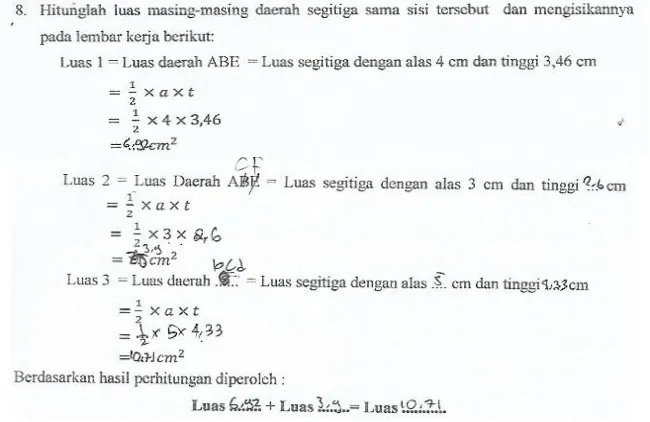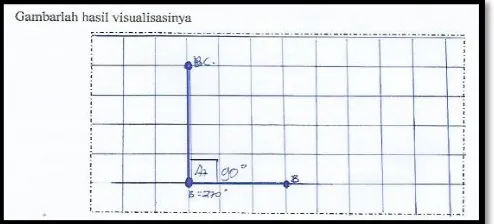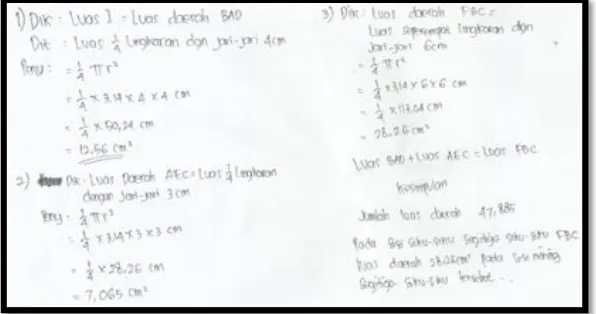717
Student
s’
Ability
in
Proving
Pythagorean
Theorem through Discovery Learning Model
Using Geogebra Software
1*
Fathiya Salsabila,
2Rahmah Johar and
3Susanti Panca Wahyuni
1,2
Department of Math Education, Faculty of Teacher Training and Education, University of Syiah Kuala, Banda Aceh 23111, Indonesia;
2
Junior High School 6, Banda Aceh 23125, Indonesia;
*
Corresponding author: fathiyasalsabila11@gmail.com
Abstract
Learning math is like training logical thinking, intelligence, focus and also systematics. One of the most important materials in math is Pythagorean Theorem. It is used in many aspects of life and helps us to solve daily problems. However, many students still cannot use it we even they have learned it. The aim of this study research is to describe
the students’ learning ability process through discovery learning model
using GeoGebra software on Pythagorean Theorem. The subjects of this study were the students of SMP Negeri 6 Banda Aceh 29 students of grade VIII-8. The data which was analyzed is formed tasks which were done in groups and video analysis. The results of study showed that the students are able to accomplish worksheet through GeoGebra assisted and all of them are able to take conclusion symbolically yet not by using their own words. The first group was failed to count third area but they succeeded on counting other areas which lead them to the right
conclusion. The second group’s fault was on naming a square
particularly on its third area however they were better taking the right conclusion. The obstacles of learning process were (1) limitation of time, (2) only some students practice using GeoGebra software, (3) laptops used were slow and not responding, (4) even the student did not understand the beginning explanations.
Keywords: learning, discovery learning model, GeoGebra software, Pythagorean Theorem. questions which exist in National Examination (UN). Kurniawati (2015) declares that
718 Math case is dominated to real problem gotten in daily life, yet in math conventional learning process, the teacher only teaches the materials. A concept, theorem, proposition, and etc., appear as if they were taken for granted without past discovery process or it is legacy of the past. This case causes students’ disability to understand some logarithm (Offirstson, 2014). The observation done by Murniasih (2015) showed that from 24 students who learned Pythagorean Theorem, only 15 students passed the Minimal Completeness Criteria (MCC); MCC applied in the school is 65. According to Murniasih (2015), Student’s Mistakes in Pythagorean Theorem concept are (1) students still misunderstand about story questions that causes they failed to change it into math model, (2) students still failed in counting quadratic values, and (3) students are careless in doing the tasks so it makes them got a wrong final result. Furthermore, the research conducted by Arfiyanti, Irawan, and Purwanto (2016) showed that the students still misunderstand about Pythagorean Theorem. They face difficulty if the Pythagorean Theorem test is formed and not . They are used to memorize the formula and not understand the meaning of the formula which has been learned.
In learning process, the students have to be used to solve the problem, and to find out their own ideas. According to Offirstson (2014), studying and learning have to
be packed into a learning process construction and not only taken from teachers’
teaching. In teaching math, teachers should facilitate the learning process by using ways which make an information becomes valuable and relevant to the students.
Learning model which makes the students active and find their own concept is Discovery Learning. According to Sund (1975) Discovery Learning is a learning process that makes students find the idea without getting it directly from the teachers. They get it by their selves. Purwatiningsih (2013) declares that Discovery Learning used in learning process can increase students’ result achievement. The
statement above in line to Effendi’s research result (2012) claims that using
Discovery Learning assists students’ achievement ability and problem solving to be better. In addition, Yang, Liao, Ching, Chang, and Chan’s study result (2010) indicates that the learning process using Discovery Learning model produces
students’ concept retention better. While Joyce & Weil (1992, in Fajri, Johar & Ikhsan:2016), the advantages of Discovery Learning are to support the students to develop their intelligences and to increase their curiosity and to find out the answer of the curiosity as well.
The rapid technology development with various technological models facilitates us to do particular activities. One of activities we are easy with by technology is
learning-teaching process. Syah (2015) claims that to expand students’ thought in learning
process, mastering science and technology, math is extremely needed. Learning principle based on Ministry National Education Republic of Indonesia 2016 Number 22 is to use media of information and communication technology increasing efficiency and effectiveness in learning. Students can understand abstract contents assisted by technology. In accomplishing the Pythagorean Theorem, teachers can use technology. According to Wasriono, Syahputra and Surya (2015), visual technology-assisted development need to be applied in teaching-learning process to relieve students to understand the concepts. While Calder and Campbell (2016) argue that particular characteristics in learning process using digital technology enable alternative solutions. High-level thinking and problem solving skills related to
students’ ways of getting information by using digital technology.
719 numerical. They are connected dynamically one another. And that leads students to learn geometry objects particularly Pythagorean Theorem which is abstract. According to Hohenwarter and Fuchs (2004), using GeoGebra software can lead students to find out and demonstrate and visualize math concepts. Lubis and Listiani (2016) state that the GeoGebra is applied to increase the concept of understanding.
Besides, Zulnaidi and Zakaria’s research result (2012) showed that the use of
GeoGebra can increase students’ achievement in comprehending concept and math procedure.
Based on the explanation above, the research questions are:
1. How do the students’ ability in proving Pythagorean Theorem through Discovery Learning Model Using GeoGebra software?
2. What are the obstacles of learning using Discovery Learning model using GeoGebra software on Pythagorean Theorem?
Research Method
The study was conducted to describe students’ ability through Discovery Learning model using GeoGebra software. The subjects of this research are 29 students of SMP Negeri 6 Banda Aceh grade VIII-8 year 2017/2018.
This study was held on Monday, May 10th 2017. The instrument was the students’ worksheet worked in group. There were 5 groups consisting of 5-6 students who were chosen randomly. Each group found Pythagorean Theorem concepts using GeoGebra software. Then, the data was analyzed in descriptive qualitative.
Results and Discussion
The using of laptop in learning process made students enthusiastic and the tasks which were done seemed so real. In the process of learning, teacher divided pupils into 5 groups and all of them succeeded to conclude the argumentation symbolically yet they were failed to take conclusion through their own words. Here are pictures of
students’ ability in proving Pythagorean Theorem until symbolic steps.
Figure 1. 1th group’s answer on symbolic step.
8. Determine the area of each equilateral triangle and write the solution on the following worksheet:
720 = = = 6.92 cm2
Area 2 = Area ACF = Area triangle with base 3 cm and height 2,6 cm = = = 3,9 cm2
Area 3 = Area ABE = Area triangle with base 5 cm and height 4,33 = = = 10,71 cm2
Based on the student result: Area 6,92 + Area 3,9 = Area 10,71
Figure 2. 2ndgroup’s answer on symbolic step.
6. Determine the area of each square and write the solution on the following worksheet:
Area 1 = Area ABGF = Area square with face 4 cm = = = 16 cm2
Area 2 = Area ACHI = Area square with face 3 cm
= = = 9 cm2
Area 3 = Area BCFG = Area square with face 5 cm
= = = 25 cm2
Based on the student result:
Area 16 cm2 + Area 9 cm2 = Area 25 cm2
721 6. Determine the area of each quadrant and write the solution on the
following worksheet:
Area 1 = Area BAD = Area quadrant with radius 4 cm = = = 12,56 cm2
Area 2 = Area ACF = Area quadrant with radius 3 cm = = = 7,065 cm2
Area 3 = Area BEC = Area quadrant with radius 5 cm = = = 19,625 cm2
Based on the student result:
Area BAD + Area ACF = Area BEC
Figure 4. 4thgroup’s answer on symbolic step.
6. Determine the area of each square and write the solution on the following worksheet:
Area 1 = Area ABGF = Area square with face 4 cm
= = = 16 cm2
Area 2 = Area ACHI = Area square with face 3 cm
= = = 9 cm2
Area 3 = Area CBDE = Area square with face 5 cm
= = = 25 cm2
Based on the student result:
Area ABGF + Area ACHI = Area CBDE
First group was still failed in counting. It was supported by Murniasih’s research (2015) which states that students who are less attention during task’s introduction will produce bad final result. The example is on the picture below.
Figure 5. 1st group’s answer on 8th step.
722 = =
= 10,71 cm2 = 10,82
Either first group or second group mistakenly understood the statement so it led them to a wrong answer. In line to Priyanto, Suharto, and Trapsilasiwi’s research (2015) that declare that question transformation error done by students amounts 49% like on the picture below:
Figure 6. 1stgroup’s answer on transformation.
Based on the student result:
Area 6,92 + Area 3,9 = Area 10,71
Area 1 + Area 2 = Area 3 or Area ABE + Area ACF = Area BCD
Figure 7. 2nd group’s answer on transformation.
Based on the student result:
Area 16 cm2 + Area 9 cm2 = Area 25 cm2
Area 1 + Area 2 = Area 3 or Area ABGF + Area ACHI = Area BCED
The second group’s second step was less precise in drawing and observing a
triangle. Furthermore, Priyanto, Suharto, and Trapsilasiwi (2015) support the
statement by their finding which found that 46% of students’ question
understanding error and it is added by Murniasih (2015) who argue that the students are less precise to understand word problem in math and task finishing process like the following pictures
723
Figure 9. 2nd group’s answer (fault on observing a triangle).
Area 3 = Area BCFG = Area square with face 5 cm =
= = 25 cm2
On conclusion section, all groups were less precise to take conclusion. Priyanto, Suharto, dan Trapsilasiwi (2015) support the finding by stating that the fault in final answer of students is amounts 61%. Conclusion section: first group could not conclude that task. Second and third group would be 100% correct if they were not failed to interpret the question. And the fourth and fifth groups were failed in concluding. Those are showed in the pictures below.
Figure 10. 1st group’s answer on taking conclusion.
Figure 11. 2nd group’s answer on taking conclusion.
Figure 12. 3rdgroup’s answer on taking conclusion. BCED
724
Figure 13. 4thgroup’s answer on taking conclusion.
Picture 10, 11, 12 and 13 are learners drawing conclusions according to the definition. The last group did not write the answer on their worksheet. Nevertheless, based on the video analysis they did it in another paper. The last group was failed to count third area but they succeeded on counting other areas which lead them to the right conclusion.
Figure 14. Fifth group’s answer.
1) Area 1 = Area BAD = Area quadrant with radius 4 cm = = = 12,56 cm2 2) Area 2 = Area AEC = Area quadrant with radius 3 cm
= = = 7,065 cm2 3) Area 3 = Area FBC = Area quadrant with radius 6 cm
= = = 28,26 cm2
Based on the student result: Area BAD + Area AEC = Area FCD
Based on the data analysis, the summary is the students enable to accomplish student worksheet through GeoGebra software and all of them enable to take conclusion symbolically yet not by using their own words. The first group was failed to count third area but they succeeded on counting other areas which lead them to
the right conclusion. The second group’s fault was on naming a square particularly on its third area however they were better taking the right conclusion. Furthermore, math teacher never uses computer software in learning process and also seldom transforms students into groups. The statements were based on researcher and
math teacher’s interview section. The barriers faced by math teacher were a
725
Conclusions
GeoGebra software can be used as media or multimedia to learn Pythagorean Theorem. From 5 groups mentioned, student can conclude the material symbolically yet not by using their own words. In addition, the obstacles of learning process were a limitation of time, in software socialization, only few of students wanted to try using the software and the laptops used were slow, even the student did not understand the beginning explanations, the laptops used were slow and they were sometimes not responding that caused the students could not finish the student worksheet on time. Teachers should more often integrate the media in learning.
References
Arfiyanti, D., Irawan, E. B., & Purwanto. (2016). Answers to problem analysis of the concept of Pythagoras theorem in student of Class VIII. In Prosiding Seminar
Nasional Matematika dan Pembelajarannya “Tren Penelitian Matematika dan Pendidikan Matematika Abad 21” (pp. 1-5). Malang: Universitas Negeri Malang. Calder, N. & Campbell, A. (2016). Using mathematical apps with reluctant learners.
Digital Experiences in Mathematics Education, 2(1), 50–69.
Efendi, L.A. (2012). Mathematical learning with guided discovery methods to improve representation and mathematical problem solving ability of junior high school students. Jurnal Penelitian Pendidikan, 13(2), 1-10.
Fajri, H. N., Rahmah, J., & Ikhsan, M. (2016). Improvement of spatial ability and student self-efficacy through multimedia based discovery learning model. Jurnal Beta, 9(2), 180-196.
Hadiyanto, F.R., Susanto, H. & Qohar, A. (2017). Identify Class VII student error in
solving geometry problem. In Seminar Nasional Matematika dan
Pembelajarannya (pp. 332-339). Malang: Universitas Negeri Malang.
Hohenwarter, M. (2008). Teaching and learning calculus with free dynamic mathematics software system GeoGebra. TSG 16: Research and Development in the Teaching and Learning of Calculus ICME 11 (pp. 1-9). Monterrey, Mexico. Hohenwarter, & M., Fuchs, K. (2004). Combination of Dynamic Geometry, Algebra
and Calculus in the Software System GeoGebra. In Computer Algebra Systems and Dynamic Geometry Systems in Mathematics Teaching Conference 2004 (pp. 1-6). Pecs, Hungary.
Kurniawati, A. (2015). Diagnosis of junior student difficulties in problem solving on pythagoras theorem material as well as its addressing efforts using scaffolding (unpublished thesis). Universitas Negeri Malang, Malang.
Lubis, I., S. & Listiani, T. (2016). The effectiveness of Geogebra usage on the results of mathematics student Class XII Science High School Daan Mogot West Jakarta in material program linear Year 2014/2015. In Pengembangan 4C’s dalam Pembelajaran Matematika:Sebuah Tantangan dalam Pengembangan Kurikulum Matematika (pp. 229 – 235). Malang: Universitas Negeri Malang.
Murniasih, T., R. (2016). Use of manipulative media to enhance student concept
understanding on pythagoras theorem. In Pengembangan 4C’s dalam
Pembelajaran Matematika: Sebuah Tantangan dalam Pengembangan Kurikulum Matematika (pp. 142 – 152). Malang: Universitas Negeri Malang.
Offirstson, T. (2014). Mathematics learning activity through Cinderella Software Assisted Inquiry. Yogyakarta: Deepublish.
Priyanto, A., Suharto, & Trapsilasiwi, D. (2015). Analysis of student error in solving mathematical story problems theory of pythagoras theorem based on category of Newman Error in Class VIII A Junior High School 10 Jember. Artikel Ilmiah Mahasiswa, 1-5
726 Scherer, R., & Beckmann, J. F. (2014). The acquisition of problem solving competence: evidence from 41 countries that math and science education matters. Large-scale Assess Educ, 2(1), 1-22.
Sund, R.B. (1975). Teaching science through discovery. Columbus, Ohio: Charles Merril Publishing Company.
Syah, E. F. (2015). Development of Problem-Based Statistics Learning Module (Problem Based Instruction) in Class XI Science Senior High School 1 Cilegon. Jurnal Edukasi Matematika, 6(12), 730-779.
Wasriono, Syahputra, E., & Surya, E. (2015). Development of autograph assisted learning tool to improve understanding of smk student mathematics concept through guided discovery. Jurnal Paradikma, 8(3), 52-61.
Yang, E. F. Y., Liao, C. C. Y., Ching, E., Chang, T., & Chan, T.W. (2010). The effectiveness of inductive discovery learning in 1: 1 mathematics classroom. In Proceedings of the 18th International Conference on Computers in Education (pp. 743-747). Putrajaya, Malaysia: Asia-Pacific Society for Computers in Education. Zulnaidi, H., & Zakaria, E. (2012). The effect of using geogebra on conceptual and





